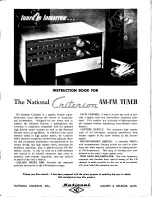
Product Description
Operating principle
10
Hans Turck GmbH & Co. KG | T +49 208 4952-0 | F +49 208 4952-264 | [email protected] | www.turck.com
4.2
Properties and features
n
TCP/IP
n
Freely programmable Ethernet-based reader based on Linux
n
Programming languages C, C++, NodeJS, Python
n
Software components: SSH, SFTP, HTTP, IBTP, MTXP, DHCP, SNTP, Node.js 6.9.5 (LTS),
Python 3.x
n
Implementation of the protocol required
n
2 W (ERP) maximum output power
n
4 RP-TNC terminals for passive external UHF RFID antennas
n
4 configurable digital channels as 2 A PNP inputs and/or outputs
n
10 Mbps/100 Mbps transfer rate
n
Integrated web server
n
LEDs and diagnostics
4.3
Operating principle
The readers are used for contactless data exchange with tags. For this the controller sends com-
mands and data via the interface to the reader and receives the corresponding response data
from the reader. The reading of the IDs of all RFID tags in the read area or the writing of an RFID
tag with a specific production date are examples of typical commands. To communicate with
the tag, the data of the reader is coded and transferred via an electromagnetic field, which at
the same time supplies the tags with power.
A reader contains a transmitter and a receiver, an interface to the interface module and a coup-
ling element (coil and dipole antenna) for communicating with the tag. Electromagnetic wave
propagation is used for the transmission between reader and tag on devices for the UHF range.
IC Tag
UHF: electromagnetic wave
Reader
Fig. 3: Operating principle of UHF-RFID
The antenna of the reader generates electromagnetic waves. This produces a transmission win-
dow as a so-called air interface in which the data exchange with the tag takes place. The size of
the transmission window depends on the combination of readers and tags, as well as on the
relevant environmental conditions.
Each reader can communicate with a number of tags. This requires the reader and the tag to
operate in the same frequency range. Depending on the power and frequency used, the device
ranges vary from a few millimeters up to several meters. The specified maximum read/write dis-
tances only represent typical values under laboratory conditions without allowing for the effect
of materials. The achievable distances may vary due to component tolerances, the mounting
situation in the application, ambient conditions and the effect of materials (particularly metal
and liquids).
Содержание 100000897
Страница 1: ...Your Global Automation Partner Instructions for Use TN UHF LNX UHF Reader...
Страница 2: ...2 Hans Turck GmbH Co KG T 49 208 4952 0 F 49 208 4952 264 more turck com www turck com...
Страница 19: ...V02 00 2021 05 19 Right click the Ethernet adapter Start the Topology scan Fig 16 Starting the Topology scan...
Страница 69: ...V02 00 2021 05 69 fclose fh else printf failed on writing n return 1...
Страница 75: ...V02 00 2021 05 75 else printf failed on writing n return 1 return EXIT_SUCCESS...
Страница 91: ...V02 00 2021 05 91 Restart the device to complete the update Click Reboot Fig 65 Restarting the device...
Страница 93: ...V02 00 2021 05 93 Select RS485 RFID and confirm with OK Fig 67 Selecting the RS485 interface...
Страница 97: ...V02 00 2021 05 97 Click the Select BL File button Fig 73 Button selecting a BL file...
Страница 106: ...Over 30 subsidiaries and over 60 representations worldwide www turck com 100003067 2021 05 100003067...











































